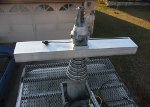|
While an hsmm-mesh node automatically configures itself to connect to other hsmm-mesh nodes, sometimes you might need to make changes to its configuration using the command line interface. One of the packages that is installed on the node is busybox, which includes a number of tools. One of these tools is an editor called vi.
The vi editor has been around since the early days of UNIX. A short history of the vi editor can be found here: http://www.softpanorama.org/Editors/Vimorama/history.shtml.
Today, there are lots of editors being used on linux, wysiwyg editors, context sensitive editors, extensible editors. Unfortunately, none of those editors are available on the hsmm-mesh nodes (to my knowledge). The problem with fancy editors is that the more features they use, the bigger they are, and the more burdened the CPU becomes.
When I was at UT/Austin, I started off with the emacs editor. It was wonderful. I could write macros in lisp and spend more time playing with emacs than with the program I was supposed to be writing. Alas, as the end of the semester approached, more and more people were online, and the editor became slower and slower. In the end I was forced to use vi just to get my work done.
The vi editor isn't that difficult to use. Unforunately, hsmm-mesh nodes lack the usual online documentation (man pages), so there's no help available for vi. However, there are tutorials available online. Here's one: http://www.eng.hawaii.edu/Tutor/vi.html. As you start to use the vi editor on your mesh node, just remember that the vi editor that comes with busybox has a reduced feature set. Even a small editor like vi has too many features for use on a mesh node. |
